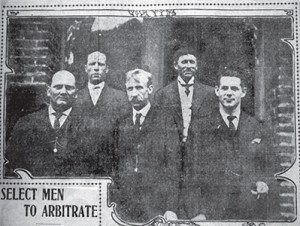
IBEW 151 leader Harry “H.L.” Worthington, on left, was elected to lead the delegation of seven unions negotiating as a group with Patrick Calhoun of United Railroads. In the middle is Richard Cornelius, president of the Street Carmen’s union. 1906. Chronicle/SFHC/SFPL/SB 18
IBEW 151 linemen, electricians and stationmen at United Railroads went on strike for the 8-hour day on July 18, 1906. Over the next several weeks they persuaded the company’s other unions to join the walk-out: Street Carmen, Stationary Engineers, Stationary Firemen and Oilers, Steam Fitters, Machinists, Teamsters, and Track Layers. This “joint conference” of unions was headed by Harry Worthington, president of the IBEW’s Pacific District Council. It was an early and bold example of “industrial” unity. Company President Patrick Calhoun hired the notorious strikebreaker James Farley to import an army of scabs to run the street cars and intimidate strikers.
On September 4, shortly after the Street Carmen joined the strike, United Railroads tried to run a street car. Thousands of union supporters surrounded the car barn, deriding and cursing the scabs and assaulting the first car to come out of the barn. Later, two scabs escaped the barn and told the strikers they were forced to sleep without blankets, given food that was “unfit to eat,” and guarded by armed guards.
The standoff soon ended when both sides agreed to arbitration. Four months later the arbitration panel awarded substantial wage increases to all of the unions, and granted the eight-hour day to all but the Street Carmen. It was a sweeping victory, made possible largely by IBEW Local 151’s insistence that the local unions join together in united action.